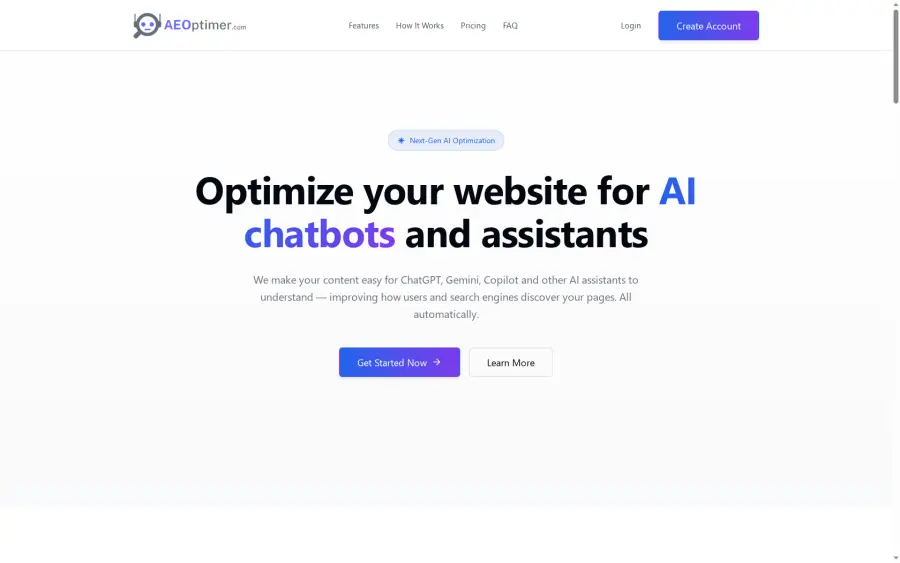7 Essential Website Owner SEO Tips for Better Visibility

Search engines process billions of queries every day, yet only a small percentage of websites manage to stand out in the results. With competition growing louder, even the best content can be overlooked if it is not optimized for modern search algorithms. Mastering a handful of practical techniques can lead to better visibility, richer snippets, and a noticeable rise in real clicks from interested visitors.
Table of Contents
- 1. Use Structured Data for Enhanced Search Results
- 2. Optimize Page Titles and Meta Descriptions
- 3. Leverage Automated Sitemap Detection Tools
- 4. Update Content Regularly for AI Trends
- 5. Ensure Fast Website Load Times
- 6. Enable Continuous Crawling and Analysis
- 7. Monitor and Review SEO Performance Monthly
Quick Summary
| Takeaway | Explanation |
|---|---|
| 1. Use structured data for better visibility | Implement schema markup to enhance search engine understanding of your content and improve rich search results display. |
| 2. Optimize page titles and meta descriptions | Create unique, compelling titles and descriptions that reflect content accurately while including relevant keywords, enhancing click-through rates. |
| 3. Leverage automated sitemap tools | Use sitemap tools to ensure search engines can efficiently discover all pages, keeping your website structure organized and up-to-date. |
| 4. Regularly update your content | Periodically review and refresh your content to align with current search trends and maintain relevance in a dynamic digital landscape. |
| 5. Monitor SEO performance monthly | Conduct monthly reviews of key metrics to understand your site’s performance and make necessary adjustments to enhance visibility. |
1. Use Structured Data for Enhanced Search Results
Imagine your website speaking a universal language that search engines understand instantly. Structured data does exactly that. This powerful technique transforms your web content into a clear, organized format that helps search engines comprehend your pages more effectively.
According to Schema.org, structured data is a standardized method of annotating web content that enables richer search results. By implementing schema markup, you tell search engines precisely what your content means, not just what it says. Think of it like adding metadata that provides context about your web pages.
Why Structured Data Matters:
- Improves search engine understanding of your content
- Increases chances of generating rich search results
- Enables more visually appealing search listings
- Potentially boosts click through rates
Practically speaking, structured data allows you to highlight specific information like product prices, review ratings, event dates, or author details. When search engines can quickly interpret this data, they can display more informative search results. This means your website could show up with eye catching snippets that stand out from standard blue links.
To implement structured data, you can use tools like Google’s Structured Data Markup Helper or JSON LD format. WordPress users can leverage plugins, while other platforms offer built in schema options. Start by marking up critical page elements such as your business information, product details, or article metadata.
With creating AI friendly website content, structured data becomes even more critical. As AI assistants increasingly power search experiences, having clear machine readable content ensures your website remains discoverable and understandable across multiple platforms.
2. Optimize Page Titles and Meta Descriptions
Your page titles and meta descriptions are like digital billboards that attract potential visitors from search results. They are your first chance to make a compelling impression and convince users to click through to your website.
According to Saint Joseph’s University, effective optimization requires precision. Page titles should be concise and descriptive, ideally no longer than 60 characters. Meta descriptions should range between 55 and 160 characters.
Key Optimization Strategies:
- Create unique titles for each page
- Include primary keywords naturally
- Write compelling descriptions that accurately represent page content
- Avoid keyword stuffing
- Use action oriented language
The University of South Florida recommends crafting meta descriptions that truly reflect your page content. Search engines like Google may use these descriptions alongside other page elements to determine how your site appears in search results.
To implement this strategy, start by auditing your current titles and descriptions. Ensure each page has a unique, descriptive title that includes your primary keyword. For meta descriptions, write clear summaries that entice users to click while accurately representing the page content.
With web page optimization techniques, remember that your goal is not just search engine visibility but also attracting genuine user interest. Think of your titles and descriptions as your website’s introduction to the world.
3. Leverage Automated Sitemap Detection Tools
Think of a sitemap as your website’s GPS navigation system for search engines. It provides a comprehensive roadmap that helps search engines discover and understand every important page on your website quickly and efficiently.
According to the University of the Fraser Valley, creating and submitting XML sitemaps is crucial for ensuring complete website indexing. Automated sitemap detection tools can streamline this process by generating and maintaining an up to date map of your website’s structure.
Key Benefits of Sitemap Tools:
- Automatically discover all website pages
- Generate XML sitemaps with minimal effort
- Ensure search engines can find new and updated content
- Identify potential crawling or indexing issues
- Keep your website structure organized
Website owners often struggle with manually tracking page changes and updates. Automated sitemap tools solve this problem by continuously scanning your site and generating fresh sitemaps. This means search engines always have the most current view of your website structure.
To get started, choose a sitemap detection tool that integrates with your website platform. Look for features like automatic updates, error reporting, and compatibility with major search engines. Some tools can even help you identify and fix potential indexing problems before they impact your search visibility.
Making websites AI discoverable becomes significantly easier when you have a robust sitemap strategy. By ensuring search engines can effortlessly navigate your content, you increase the chances of your pages being found and ranked effectively.
4. Update Content Regularly for AI Trends
The digital landscape evolves at lightning speed. Keeping your website content fresh and aligned with current AI search trends is no longer optional its a necessity for staying visible and relevant.
According to EAB, regularly reviewing and optimizing meta tags is crucial for adapting to AI driven search algorithms. This means going beyond static content and proactively updating your website to match emerging user search behaviors.
Content Update Focus Areas:
- Review page titles and descriptions
- Check keyword relevance
- Update statistical information
- Remove outdated references
- Add current industry insights
As LinkedIn emphasizes, the key is not just frequent updates but strategic ones. Avoid keyword stuffing and focus on crafting unique compelling content that genuinely serves user intent.
Start by setting a quarterly content audit schedule. Review your most important pages and look for opportunities to refresh information add recent examples and ensure your content reflects current industry trends. This approach helps your website remain dynamic and attractive to both AI search algorithms and human readers.
With website content update strategies, remember that consistent evolution is your competitive advantage. AI and search technologies are constantly learning and your content should be equally adaptive.
5. Ensure Fast Website Load Times
Imagine a digital world where visitors vanish faster than they arrive. Slow loading websites are the ultimate user repellent driving potential customers away before they even see your content.
According to Seminole State College, search engines actively favor websites that load quickly. This means your website speed is not just about user experience its a critical SEO ranking factor that can make or break your online visibility.
Website Speed Optimization Tactics:
- Compress and optimize images
- Minimize HTTP requests
- Enable browser caching
- Use content delivery networks
- Remove unnecessary plugins
Speed optimization requires a multifaceted approach. Start by analyzing your current website performance using tools like Google PageSpeed Insights. Look for specific bottlenecks that slow down your site loading times such as large image files unoptimized code or excessive server requests.
Consider technical elements like server response time browser caching and code minification. These behind the scenes tweaks can dramatically reduce load times without compromising your websites visual design or functionality.
Website optimization strategies become crucial when you understand that every second counts. Modern web users expect near instant access and search engines reward websites that deliver speedy performance.
6. Enable Continuous Crawling and Analysis
Think of search engines as digital explorers constantly mapping the vast landscape of the internet. Enabling continuous crawling ensures these explorers can easily discover and understand your website content.
According to Saint Joseph’s University, maintaining an up to date XML sitemap and submitting it to search engines is crucial for facilitating continuous crawling. This process helps search engine bots efficiently navigate and index your website.
Continuous Crawling Strategies:
- Maintain updated XML sitemaps
- Ensure clean website structure
- Monitor crawl errors regularly
- Keep content fresh and relevant
- Remove broken or outdated links
The University of the Fraser Valley recommends using specialized tools to monitor crawl errors and address issues promptly. This proactive approach prevents potential indexing problems that could impact your search visibility.
Implement a routine crawl analysis by using tools like Google Search Console. Check for technical issues such as blocked resources server errors or incorrect robot txt configurations. These small adjustments can significantly improve how search engines understand and rank your website.
How AI assistants find websites becomes easier when you create a clear accessible path for digital explorers. Continuous crawling is not just about being found its about being understood.
7. Monitor and Review SEO Performance Monthly
Think of SEO as a living ecosystem that requires constant attention and care. Monthly performance reviews are your opportunity to understand how your website is performing and make strategic improvements.
According to the University of South Florida, tracking key metrics like organic traffic bounce rates and keyword rankings is essential for maintaining search visibility. These insights help you understand what is working and what needs adjustment.
Key Performance Metrics to Track:
- Organic search traffic volume
- Keyword ranking positions
- Bounce and exit rates
- Conversion rates
- Page load times
Seminole State College recommends conducting regular SEO audits to assess website performance comprehensively. This means looking beyond surface level metrics and diving deep into your website’s search engine health.
Start by setting up tools like Google Analytics and Google Search Console. Create a monthly checklist that includes reviewing traffic sources analyzing keyword performance and identifying potential technical issues. Pay attention to trends over time rather than getting caught up in short term fluctuations.
Manual review of website optimization becomes crucial when you understand that SEO is not a set it and forget it strategy. Consistent monitoring allows you to adapt quickly to changing search engine algorithms and user behaviors.
Below is a comprehensive table summarizing the key strategies and benefits of effective SEO practices discussed throughout the article.
| SEO Strategy | Implementation | Benefits |
|---|---|---|
| Structured Data | Use schema markup language like JSON LD; tools like Google’s Structured Data Helper. | Enhances search engine understanding; increases rich result chances; boosts CTR. |
| Optimize Titles & Meta Descriptions | Create unique, keyword-rich titles and descriptions; avoid keyword stuffing; use action-oriented language. | Attracts clicks; improves search visibility; accurately represents content. |
| Automated Sitemaps | Use sitemap tools to generate and update XML sitemaps; maintain website structure. | Ensures all pages are indexed; identifies potential issues; keeps content organized. |
| Regular Content Updates | Conduct quarterly audits; update keywords, stats, and insights. | Keeps site relevant; aligns with AI trends; improves search rankings. |
| Fast Load Times | Optimize images, minimize HTTP requests, use CDNs, and cache browsers. | Improves user experience; boosts SEO rankings; reduces bounce rates. |
| Continuous Crawling | Maintain XML sitemaps, check crawl errors regularly. | Ensures efficient indexing; improves content visibility; enhances understanding. |
| Monthly SEO Performance Review | Track organic traffic, keyword rankings, and use analytics tools. | Identifies improvements; adapts to algorithm changes; maintains search presence. |
Boost Your Website Visibility Effortlessly with Automated SEO Solutions
The article highlights common challenges website owners face such as keeping content updated for AI trends, managing structured data, and ensuring continuous sitemap detection to improve search rankings and AI recognition. You want a simple, effective way to implement these vital SEO tips without the hassle of technical expertise or manual upkeep. The struggle of maintaining fast website load times and optimizing meta tags every month can feel overwhelming but staying relevant in AI-driven search is critical for growth.
Take control with aeoptimer.com, a platform built to automate exactly these tasks. It crawls and analyzes your site monthly, applies structured data enhancements, updates content strategically, and keeps your sitemap current so AI assistants like ChatGPT and Gemini can easily discover your pages — all without changing your website’s look or requiring extra effort on your part.

Start transforming your SEO approach today by leveraging automated optimization that aligns perfectly with the “7 Essential Website Owner SEO Tips for Better Visibility”. Visit aeoptimer.com now to experience ongoing improvements that keep your site visible, fast, and AI-ready with minimal work on your side. Don’t miss out on the opportunity to boost traffic and stay ahead in the AI search era.
Frequently Asked Questions
How can I use structured data to improve my website’s SEO?
Using structured data helps search engines better understand your content, potentially leading to richer search results. Start by identifying key information on your site to mark up, such as product details or author information, using schema markup.
What are the best practices for optimizing page titles and meta descriptions?
Effective optimization involves creating unique, concise titles and compelling meta descriptions that accurately reflect the page content. Aim for titles under 60 characters and meta descriptions between 55 and 160 characters to enhance your click-through rates.
How often should I update my website’s content for better search visibility?
Regularly updating your content is essential; aim for quarterly reviews to keep information current and aligned with AI search trends. Focus on refreshing outdated statistics and adding relevant insights, ensuring your website remains dynamic and relevant.
What steps can I take to improve my website’s loading speed?
To enhance your website’s loading speed, compress images and minimize HTTP requests. Start by analyzing your current load times and address bottlenecks such as large image files or excessive server requests for a better user experience.
How can I ensure continuous crawling and indexing of my website by search engines?
Maintain an updated XML sitemap and regularly monitor for crawl errors to facilitate continuous indexing. Set a schedule to keep your sitemap current and review content for freshness, ensuring search engines can easily navigate your site.
What metrics should I monitor monthly to assess my SEO performance?
Focus on key metrics such as organic search traffic volume, keyword rankings, and bounce rates. Set up a monthly SEO audit checklist to track these metrics consistently and identify areas for improvement.





